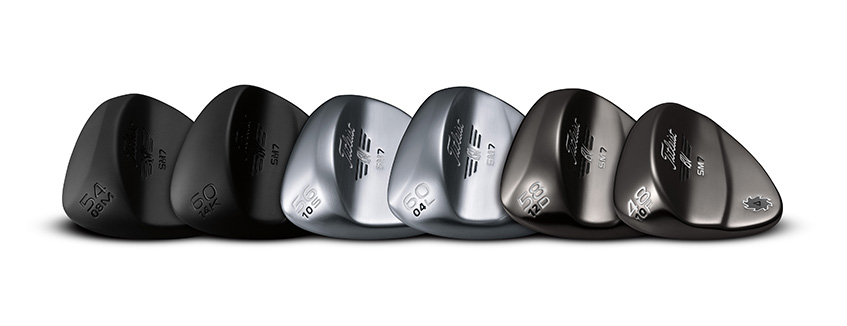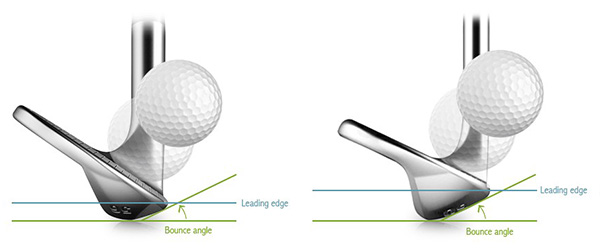Wedge Grind and Bounce Explained

Titleist Vokey SM7 Wedges, image: nationalclubgolfer.com
In an average round, a PGA Tour professional will hit about 12 greens. That leaves plenty of work for the short game. Depending on that week’s course a pro will carry three or four wedges in his or her complement of 14 clubs.
Weekend golfers hit far fewer greens and will call on their wedge game much more often. It is not unusual during some amateur rounds for the wedge to be the most-used club in the bag that is not the putter. With that in mind, getting fitted for the proper wedges for your game can be one of the most effective ways to lower scores.
What is Wedge Fitting?
There are two main areas of investigation in wedge fitting. The first is “gapping.” Iron selection in golf between 120 and 200 yards is roughly calibrated by increments of 10-12 yards. For shots between 40 and 120 yards, however, most golfers are left to choose between only a wedge and a sand wedge. The upshot is that less-skilled golfers are left with intimidating half-wedges and three-quarter wedge shots when playing in the so-called “scoring zone.” To fill in that gaping yardage club manufacturers offer wedges from 46 degrees of loft to 64. A wedge fitting will identify the lofts that work best for your wedge distances, so you can approach your scoring shots with more full swings and more confidence.
The second area of wedge fitting is the “grind.” In technical terms, grind is the angle between the leading edge of the club face (the part that strikes the ground first) and the lowest point on the sole (the bottom of the club face). The angle created between these two points and the ground when the wedge is held upright and in the address position is known as the “bounce.” You can see the grind of an iron by looking at the back of the club. Numbered irons look identical and traditionally the pitching wedge has a similar straight edge. Until recently, golfers looking to hit higher shots would open the club face for more bounce and close the club face for lower shots. Grinding the sole of a wedge accomplishes the same thing without maneuvering the club face. There are many different types of grind, designated by letters (L, S, M, etc.) that take on the many duties of the wedge – pitch shots, sand shots, low punch shots, and lob shots.

Wedge Bounce Angles, image: golfsouthhills.com
The Practical Impact of Wedge Bounce
How much bounce you need on your wedges will depend on your swing. If you like to hit your wedge with a steep descending blow and gouging out a divot in the process, you will want a higher bounce angle to help with the resistance of the ground to your swing efforts. If you strike your wedges with a shallow attack angle and prefer to pick the ball off the turf, you will prefer clubs with low bounce angles. A tendency to hit pitch shots thin is a possible indication that your wedges have too much bounce.
Playing conditions will dictate your choice of bounce nearly as much as your swing shape. If you play on soft, lush courses with bunkers that usually feature fluffy sand, high bounce wedges are the way to go. If your course is kept firm with tight lies in the fairway a low bounce angle will generate more positive results.
Like loft, bounce angles are translated in degrees, starting at 0 and reaching as high as 16. In general, a stock pitching wedge will have between 2 and 5 degrees of loft and a typical sand wedge will range from 10 to 14 degrees. Specialty gap wedges can be found with almost any configuration of loft and bounce.
To find the optimum bounce angle for your wedges, begin by evaluating your swing plane. Then analyze your game to identify those short shots you encounter most often on the golf course. Finally, match up the necessary wedge bounce best designed to tame those tricky scoring shots.
Vokey Wedge Grinds
The man most responsible for ushering grind into the golfer’s vocabulary is Bob Vokey, a Canadian son of a tool-and-die man who opened his own custom club making shop in California in the 1970s. Vokey was an early cheerleader for metal head drivers and in the 1980s went to work for industry innovator TaylorMade. After a stint helping to start Founders Club, Vokey was recruited by Titleist in 1996 where he helped design their go-to driver, the Titleist 975D.
Vokey had never worked with wedges until he volunteered during a Titleist brainstorming session. Vokey went to work with touring pros to investigate their needs in a wedge. He began grinding wedges to their preferences, and Titleist now offers exact fitting of wedges for loft, bounce and grind. With over 40% of players using Vokey-designed clubs, Titleist is the number one supplier of wedges on the PGA Tour.

Bob Vokey and Aaron Dill with Titleist SM7 Wedge, image: australiangolfdigest.com.au
Callaway Wedge Grinds Explained
Ely Callaway was a vintner who exchanged one passion for another when he sold his vineyards and bought into golf equipment companies in the 1980s. In 2002, Callaway began offering forged wedges. The Callaway Mack Daddy 4 Wedges now offered in four grinds – W, S, C, and X.
The S grind shaves off material from the sole towards the heel that is a good all-purpose grind for lower lofts; this versatile grind permits players who like to open the club face on pitch shots to do so without adding bounce and losing distance.
The C grind offers heel and toe forgiveness for all manner of shot-making it takes off bounce for precision on firm conditions.
The X grind is made for golfers who have moderate to steep angles of attack and tend to play in soft conditions.
We hope that helped explain how wedge grind and bounce can affect your game and provided enough insight to help you choose the correct variation to help you around the green. Hit ’em close!



